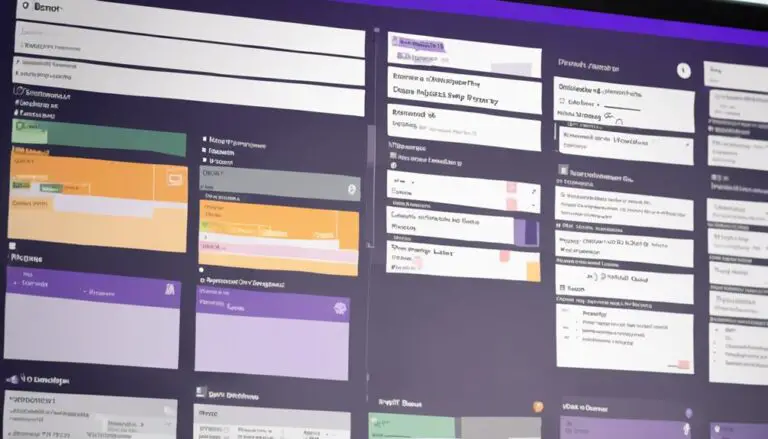Have you ever wondered if Kanban teams truly require a Scrum Master to foster effective collaboration? Many argue that the role of a Scrum Master is not necessary for Kanban teams, as Kanban focuses on continuous flow of work and does not have fixed roles or ceremonies like Scrum. However, others believe that a Kanban team can benefit from having a person dedicated to facilitating collaboration and removing obstacles, similar to the role of a Scrum Master in Scrum. Ultimately, the decision of whether a Kanban team needs a dedicated facilitator, or whether the responsibilities can be distributed among team members, depends on the specific dynamics and needs of the team. It is also important to consider the differences in the roles and responsibilities of a kanban vs scrum master when deciding on the best approach for a Kanban team.
The dynamic interplay between these two Agile methodologies raises intriguing questions about the necessity of a Scrum Master in Kanban environments.
As you explore this topic further, consider the nuanced factors that influence team dynamics and productivity, shedding light on the potential benefits and drawbacks of integrating a Scrum Master into a Kanban team.
Key Takeaways
- Kanban teams do not require a Scrum Master for effective collaboration
- Shared ownership and self-organization are fundamental in Kanban
- Leadership in Kanban focuses on empowerment and continuous improvement
- Effective collaboration in Kanban is fostered through transparency and open communication
Understanding Kanban Vs. Scrum Roles
When comparing Kanban and Scrum roles, it’s essential to understand the distinct differences in responsibilities and approaches each framework entails. In Kanban, there’s no specific role equivalent to a Scrum Master. Kanban emphasizes continuous flow and visualizing work on the Kanban board, promoting shared understanding among key stakeholders. Unlike the Scrum framework, where the Product Owner holds the responsibility of maximizing product value, Kanban teams prioritize collaboratively, fostering a sense of shared ownership.
In Kanban teams, self-organization is key to effective collaboration. Rather than relying on a dedicated Scrum Master to facilitate events and remove impediments, Kanban teams distribute these responsibilities among team members, encouraging autonomy and accountability. This shared responsibility enhances team cohesion and empowers individuals to make decisions collectively, driving continuous improvement.
Key Responsibilities in Kanban Teams
Shifting focus to the key responsibilities within Kanban teams, it becomes evident how the emphasis on continuous flow and self-organization shapes the collaborative dynamics within the team. In Kanban, managing the flow of work is crucial. Teams focus on visualizing the workflow, limiting work in progress, and continuously improving their processes. By maintaining transparency and identifying blockers, Kanban teams ensure a smooth and efficient workflow.
Decentralized decision-making is central to Kanban, empowering team members to make informed choices. This approach reduces the need for a Scrum Master, as the team collectively manages its tasks and priorities. Clear communication and a shared understanding of the work help in delivering value consistently. By focusing on these key responsibilities, Kanban teams foster a culture of collaboration and efficiency, driving towards shared goals and successful outcomes.
The Role of Leadership in Kanban
Let’s talk about the pivotal role of leadership in Kanban teams and how it influences team dynamics.
Leadership influence in Kanban is about empowering team members to take on responsibilities based on their expertise, fostering a culture of shared accountability.
Leadership Influence in Kanban
Leadership plays a pivotal role in Kanban by fostering a culture of trust, collaboration, and continuous improvement within the team. Effective leadership in Kanban involves:
- Encouraging self-organization: Leaders empower team members to make decisions and take ownership of their work.
- Promoting continuous improvement: Leaders support a culture where learning from mistakes and experimenting with new ideas are encouraged.
- Emphasizing trust and collaboration: Leaders build relationships based on trust, facilitate open communication, and encourage teamwork towards common goals.
Team Dynamics in Kanban
In Kanban, team dynamics revolve around fostering self-organization and shared responsibility for collaboration, emphasizing a distributed model of leadership where every team member plays a crucial role in driving success. This approach promotes a culture of collaboration where continuous improvement is a shared goal.
Within the team, self-organization empowers individuals to take ownership of their work and contribute meaningfully to the collective effort. Shared responsibility ensures that everyone is accountable for the team’s outcomes, fostering a sense of unity and purpose.
Enhancing Collaboration in Kanban
To enhance collaboration in Kanban, focus on implementing effective team communication strategies and embracing continuous improvement practices.
By fostering open communication channels and encouraging feedback, you can strengthen the team’s ability to work together seamlessly.
Embrace a culture of adaptability and learning, as it will lead to improved collaboration and overall team success.
Team Communication Strategies
Enhance your team’s collaboration in Kanban by implementing effective communication strategies that foster transparency and open feedback channels.
- Implement Daily Stand-up Meetings:
Conduct daily stand-up meetings to provide quick updates, identify blockers, and ensure smooth collaboration.
- Utilize Visual Management Tools:
Employ Kanban boards to enhance transparency, visualize workflow, and promote better communication within the team.
- Encourage Open Communication Channels:
Foster open channels for feedback loops to promptly address issues, improve collaboration, and strengthen team dynamics.
Continuous Improvement Practices
Enhance your Kanban team’s collaboration through continuous improvement practices that focus on streamlining communication and teamwork. By embracing agile principles and incorporating Scrum practices, your team can benefit from a structured approach to continuous improvement.
Consider having a Scrum Master onboard to guide your Kanban team in implementing new practices and fostering effective communication. The Scrum Master’s role includes coaching team members, facilitating discussions, and removing obstacles to enhance collaboration within the team.
Through regular retrospectives and feedback sessions, your team can identify areas for improvement and work together to implement changes that enhance collaboration and productivity. Embrace a culture of continuous learning and improvement to optimize your Kanban team’s collaborative processes.
Impact of Scrum Master in Kanban
The presence of a skilled Scrum Master within a Kanban team significantly influences collaboration dynamics and productivity levels. Scrum Masters play a vital role in enhancing efficiency and fostering a culture of continuous improvement within Kanban teams. Here’s how they impact Kanban teams:
- Facilitating Collaboration: Scrum Masters help Kanban teams improve collaboration by facilitating meetings, fostering open communication, and removing obstacles that hinder progress.
- Adapting Scrum Practices: Their expertise in Scrum practices can be adapted to enhance efficiency in Kanban, guiding teams on how to apply agile principles effectively.
- Promoting Continuous Improvement: Scrum Masters promote a culture of continuous improvement within Kanban teams, ensuring that the team stays focused on their goals and consistently looks for ways to enhance their processes.
With their coaching, mentoring, and ability to implement agile principles like transparency and inspection, Scrum Masters contribute significantly to the success and effectiveness of Kanban teams.
Leveraging Agile Principles for Success
After understanding the impact of Scrum Masters in Kanban teams, you can now explore how leveraging Agile principles contributes to team success and efficiency. Agile principles serve as the backbone for Kanban teams, fostering collaboration, enhancing efficiency, and promoting continuous improvement. By integrating Agile values like commitment, focus, and respect into Kanban practices, teams can streamline their processes and achieve better outcomes.
Having a Scrum Master in Kanban teams can further support the implementation of Agile methodologies. The Scrum Master’s role in facilitating Agile practices can help teams improve communication, alignment, and overall performance. Additionally, applying Scrum patterns within Kanban frameworks enables teams to adopt effective collaboration strategies without fully transitioning to Scrum itself.
Achieving Productivity in Kanban Teams
To boost productivity in Kanban teams, consider implementing daily stand-up meetings to enhance collaboration and alignment among team members.
Daily stand-ups provide an opportunity for team members to discuss progress, upcoming tasks, and any challenges faced. This regular interaction fosters a sense of unity and keeps everyone informed and motivated.
Additionally, establishing a visual board where tasks are clearly outlined and updated in real-time can help in tracking progress and identifying bottlenecks promptly. Encouraging team members to collaborate on tasks and share knowledge can further improve productivity by leveraging everyone’s strengths.
Furthermore, setting clear goals and priorities, along with regular retrospectives to reflect on ways to enhance processes, can drive continuous improvement within the team.
Frequently Asked Questions
Do You Need a Scrum Master for Kanban?
In team dynamics and workflow optimization, a Scrum Master isn’t essential for Kanban. Collaboration techniques, communication strategies, and productivity enhancement align with agile principles, making self-organization effective. Agile coaches can support continuous improvement efforts.
What Is the Role of Master in Kanban?
In Kanban, the Master plays a pivotal role in team dynamics, process improvement, continuous delivery, workflow visualization, stakeholder engagement, and Lean principles. Their support enhances collaboration and efficiency, fostering a culture of transparency and growth.
What Is the First Practice a Team Needs to Master When Using Kanban?
To excel in Kanban, start by mastering the art of visualizing workflow. Embrace setting WIP limits, tracking cycle times, and holding daily standups. Nurture a culture of continuous improvement and prioritize team collaboration for effective synergy.
When Might You Not Need a Scrum Master on a Team?
When team members are self-managed, empowered, and well-versed in Lean and Agile practices, the need for a Scrum Master diminishes. Autonomy over control, strong collaboration dynamics, and a deep understanding of team roles foster effective collaboration without a dedicated Scrum Master.
Conclusion
In conclusion, while Kanban teams may not necessarily need a Scrum Master for effective collaboration, having one can greatly benefit the team by implementing Scrum practices within a Kanban context.
By leveraging agile principles and embracing the role of leadership, a Scrum Master can help enhance collaboration, improve processes, and ultimately drive productivity in Kanban teams.
So, consider the truth that a skilled Scrum Master can indeed elevate the success of a Kanban team.





